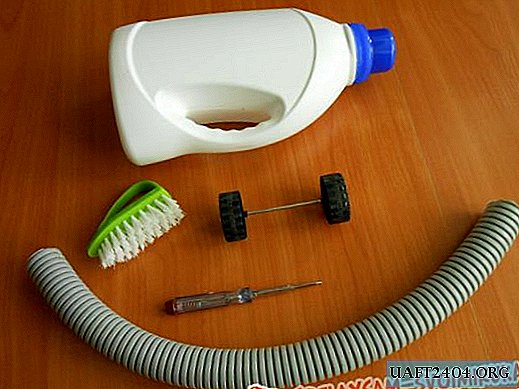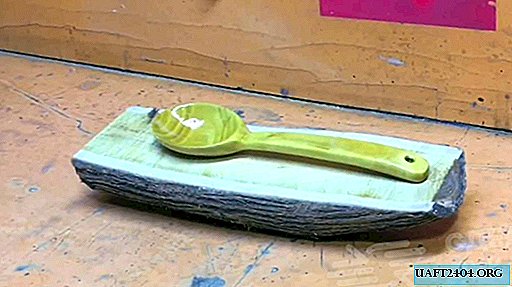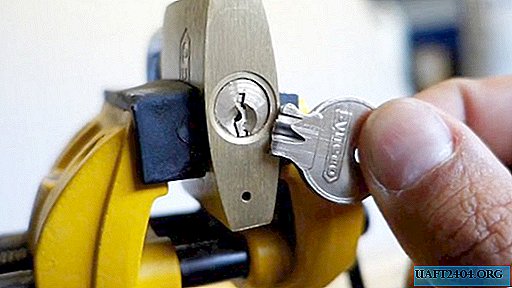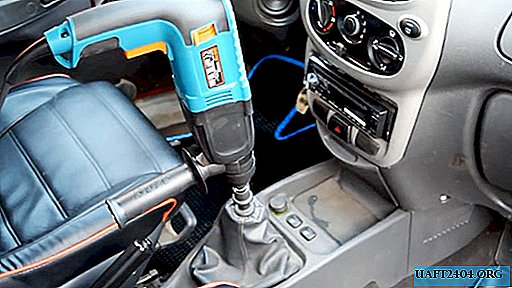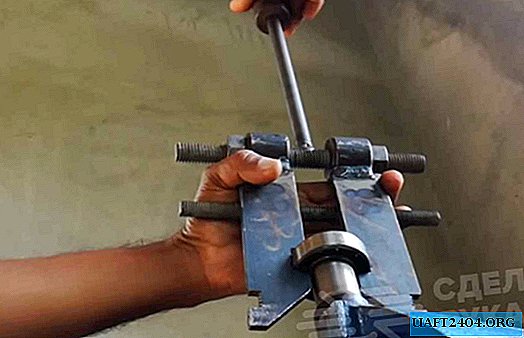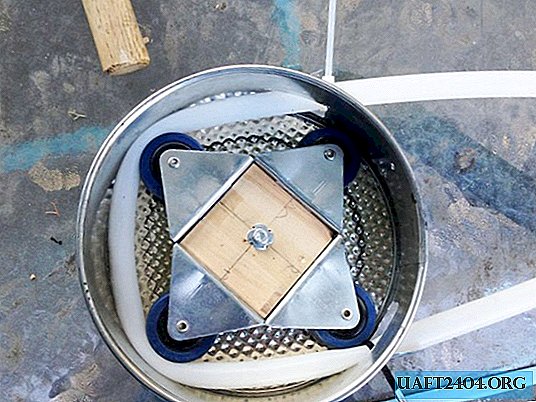Share
Pin
Tweet
Send
Share
Send
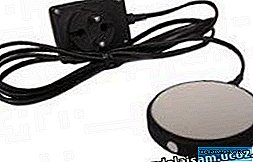
An ultrasonic washing machine is intended for washing clothes with the help of sound vibrations created in the washing solution, the frequency of which is close to ultrasonic. The features of the trigger are that when washing there is no mechanical friction of the laundry, the laundry after washing the trigger is completely disinfected, the power consumption of the device is not more than 15 watts.
The device of an ultrasonic washing machine consists of a power supply unit, made according to a formatless diagram, a pulse generator on transistor VT1, a piezoceramic emitter in a sealed waterproof housing. The pulse voltage from the generator is increased to 50 - 55 V using a Tpl transformer. The pulse repetition rate in the range of 18-30 KHz. LED VD5 is designed to indicate the operation of the generator.
The device of an ultrasonic washing machine consists of a power supply unit, made according to a formatless diagram, a pulse generator on transistor VT1, a piezoceramic emitter in a sealed waterproof housing. The pulse voltage from the generator is increased to 50 - 55 V using a Tpl transformer. The pulse repetition rate in the range of 18-30 KHz. LED VD5 is designed to indicate the operation of the generator.

Manufacture
The circuit diagram of the device is shown in Fig. 1, a drawing of a printed circuit board with the arrangement of elements - in fig. 2. The pulse transformer is wound on a closed Ш - shaped core made of soft magnetic ferrite of type 600 PV, which is glued from two Ш - shaped cores Ш бхб. The winding I contains 70 turns of wire PEV-0.3, the winding II contains 10 turns of wire PEV-0.3. Sh winding - 450 turns of the same wire.
Winding is carried out on a two-section frame made of electric cardboard, coil to coil: winding III is located in one section; I and P - in another, and winding II is wound over winding I. After winding, the frame is placed on the middle core of the core Ш бхб, the second core Ш бхб is glued on top with glue BF-2, forming a closed magnetic circuit. The printed circuit board is made of foiled single-sided fiberglass SF 1.5 ... 2 mm thick.
After assembling and adjusting the USM Tpl, it is advisable to fill it with epoxy resin or sealant. When using serviceable parts and proper assembly, the circuit starts working immediately. In the absence of generation (by ear), it is necessary to swap the ends of the winding I. The piezoceramic emitter Z1 in the author's design uses an industrial disk form (Fig. 3) made of ceramics like TsTS-9. As a replacement, one can recommend piezoelectric transducers of the ZI-19 type and the like, connected as shown in Fig. four.
The hole in the plastic shell of the emitter is carefully expanded to a diameter of 20 mm. The piezoelectric emitter (Fig. 3) is placed in the housing (Fig. 5), glued from three sheets of plexiglass, fixed in the middle sheet with glue: after sewing with wire, it is filled with sealant to seal the joints. Fill flush with the surfaces of the outer sheets. The channel for the passage of the wire in the housing is also filled with sealant. The circuit diagram of the device is housed in an old power supply unit (for example, from a microcalculator) and is connected to the radiator by a 2500 mm long vinyl-chloride sheath. The use of high-frequency dynamic 4GDV type heads as emitters in the design is permissible, but their service life is short.
When installing the head in a housing similar to that shown in fig. 5, it must be insulated (wrapped) with thin rubber with tension (especially above the horn of the head), then fill with sealant.
Device operation
Soak heavily soiled laundry 2-3 hours before washing. To wash in containers with a volume of not more than 15-20 liters in the following sequence:
1. Prepare a washing container with a ratio of bottom width to height of at least 1: 1.5 (bucket, deep basin, etc.)
2. Fill the container with water at a temperature of 40-50 ° C for synthetics or 60-65 ° C for cotton and linen. Check the temperature on the label of the erased fabric.
3. Pour detergent into water.
4. Lower the emitter to the middle of the tank.
5. Immerse the laundry (not more than 1.5 kg dry weight). Make sure that the laundry floats freely in the washing solution. Soap heavily contaminated places with soap.
6. Connect the device to the network.
7 The washing time is 30-90 minutes; in the process of washing, turn the laundry around once every 10-15 minutes. The washing process is invisible. USM is also effective in soaking laundry before washing in a conventional machine, while the effect of disinfection is also preserved.
8. After washing the trigger, disconnect the trigger from the network, rinse and dry the emitter.
9. Rinse the laundry.
The use of the trigger is especially effective when washing thin woolen items of thin linen, etc. Things at the same time do not twist, do not stretch and do not lose shape.
The circuit diagram of the device is shown in Fig. 1, a drawing of a printed circuit board with the arrangement of elements - in fig. 2. The pulse transformer is wound on a closed Ш - shaped core made of soft magnetic ferrite of type 600 PV, which is glued from two Ш - shaped cores Ш бхб. The winding I contains 70 turns of wire PEV-0.3, the winding II contains 10 turns of wire PEV-0.3. Sh winding - 450 turns of the same wire.
Winding is carried out on a two-section frame made of electric cardboard, coil to coil: winding III is located in one section; I and P - in another, and winding II is wound over winding I. After winding, the frame is placed on the middle core of the core Ш бхб, the second core Ш бхб is glued on top with glue BF-2, forming a closed magnetic circuit. The printed circuit board is made of foiled single-sided fiberglass SF 1.5 ... 2 mm thick.
After assembling and adjusting the USM Tpl, it is advisable to fill it with epoxy resin or sealant. When using serviceable parts and proper assembly, the circuit starts working immediately. In the absence of generation (by ear), it is necessary to swap the ends of the winding I. The piezoceramic emitter Z1 in the author's design uses an industrial disk form (Fig. 3) made of ceramics like TsTS-9. As a replacement, one can recommend piezoelectric transducers of the ZI-19 type and the like, connected as shown in Fig. four.
The hole in the plastic shell of the emitter is carefully expanded to a diameter of 20 mm. The piezoelectric emitter (Fig. 3) is placed in the housing (Fig. 5), glued from three sheets of plexiglass, fixed in the middle sheet with glue: after sewing with wire, it is filled with sealant to seal the joints. Fill flush with the surfaces of the outer sheets. The channel for the passage of the wire in the housing is also filled with sealant. The circuit diagram of the device is housed in an old power supply unit (for example, from a microcalculator) and is connected to the radiator by a 2500 mm long vinyl-chloride sheath. The use of high-frequency dynamic 4GDV type heads as emitters in the design is permissible, but their service life is short.
When installing the head in a housing similar to that shown in fig. 5, it must be insulated (wrapped) with thin rubber with tension (especially above the horn of the head), then fill with sealant.
Device operation
Soak heavily soiled laundry 2-3 hours before washing. To wash in containers with a volume of not more than 15-20 liters in the following sequence:
1. Prepare a washing container with a ratio of bottom width to height of at least 1: 1.5 (bucket, deep basin, etc.)
2. Fill the container with water at a temperature of 40-50 ° C for synthetics or 60-65 ° C for cotton and linen. Check the temperature on the label of the erased fabric.
3. Pour detergent into water.
4. Lower the emitter to the middle of the tank.
5. Immerse the laundry (not more than 1.5 kg dry weight). Make sure that the laundry floats freely in the washing solution. Soap heavily contaminated places with soap.
6. Connect the device to the network.
7 The washing time is 30-90 minutes; in the process of washing, turn the laundry around once every 10-15 minutes. The washing process is invisible. USM is also effective in soaking laundry before washing in a conventional machine, while the effect of disinfection is also preserved.
8. After washing the trigger, disconnect the trigger from the network, rinse and dry the emitter.
9. Rinse the laundry.
The use of the trigger is especially effective when washing thin woolen items of thin linen, etc. Things at the same time do not twist, do not stretch and do not lose shape.
Share
Pin
Tweet
Send
Share
Send


